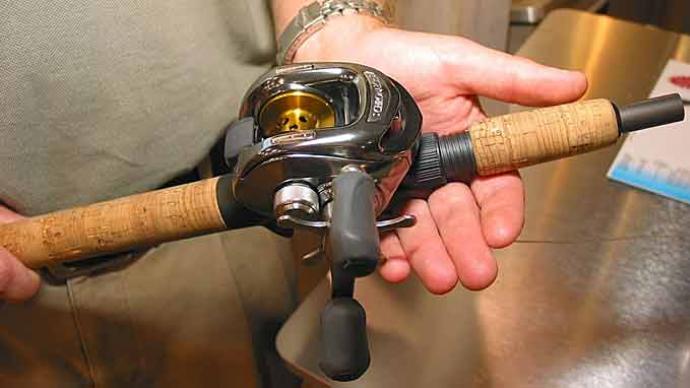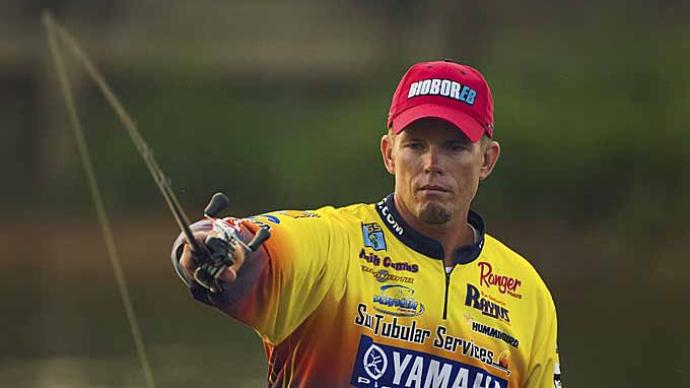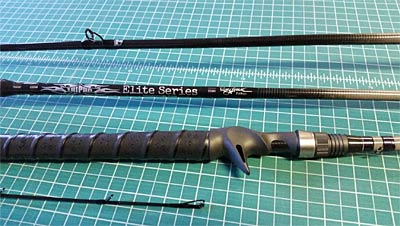
You love bass fishing, or you wouldn’t be on this site, right? Odds are, at one time or another, you’ve wished you could get a job that would let you set your own hours and make money doing something related to fishing. Here’s how three people I know did just that.
Taipan Rods
Simon Apodacha of Yuma, Arizona, started building rods in 1996 but kept it low-key, building for himself, friends, and locals who spread the word about them. He had learned to make blanks, and in 2010 he started to build his rod-making equipment. In 2014, he decided to go all in, so he quit his job as a truck driver, and in 2017 he got his shop. Until then, he’d been building rods and making blanks in his garage and one room in his house. The decision to quit his job was nerve-wracking since he has a family to support, but now he has a 2500-square foot facility, a couple of employees, plus his wife and daughter, who help build rods.
His business is still growing, primarily by word of mouth. He had spotted a small ad in a national fishing magazine that said “Build Your Own Rods,” and he thought, “I need to do something different because everyone will be making their own rods.” That’s what made him focus on making and selling rod blanks. He still makes and sells rods, but he sells blanks all over the nation for other companies and individuals to use when building custom rods.
What makes Taipan Rods unique is how the guides wrap around the rod so that the line doesn't rub on the rod when you cast or set the hook or reel the big one in. Also, his rods and blanks are designed and built to be incredibly strong – they are 100% graphite with no scrim. His proprietary Double X Core technology means that the rods stay round even when heavily loaded – the Double X Core ply constructions give them incredible strength, so they don’t start to oval out under stress like other rods. He guarantees his rods for life.
He says the fishing industry is highly competitive, and building his business has been an ordeal but lots of fun. The one thing people don’t realize, he says, is that the guy making the rods doesn’t get to keep all the money. Those tackle shops have to make a significant percentage off things to stay in business, and all businesses have costs like supplies, transportation of goods, taxes, payroll, etc. It’s a lot to learn, but sticking with it can be worth it. Simon sponsors well-known western anglers like Matt Shura, Johnny Johnson, and Roy Hawk. Good team members greatly help get the word out about a great product.
Simon’s secret to success is to make a superior product, stand behind it, and not rush things. He loves his work – one of the things he enjoys most is seeing videos of people catching their biggest fish on Taipan Rods. “I love hearing the excitement in their voices and thinking, ‘hey, I’m part of that,” says Simon. “When you get the once-in-a-lifetime fish on, and the rod breaks, it breaks your heart -- I love to help people land that fish of a lifetime.” You can see Simon’s Taipan Rods (named after the deadliest snake in Australia) at www.taipanrods.com.
Making Baits
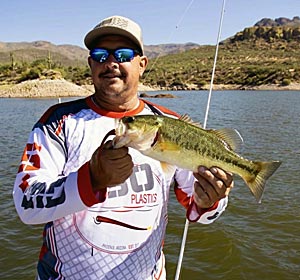
Three avid bass fishermen in Arizona who have been friends since kindergarten had always talked about making their baits and experimenting with different colors. They finally bought some molds and started making their worms for personal use. But Dave Hernandez, one of the three amigos, has a son in the Phoenix Junior Bassmasters Club. In this club, the kids fish tournaments against each other, but an adult has to pilot the boat. These boat captains are often tournament fishermen who volunteer to help the kids out on Sundays. Dave had been donating baits to the club, and those baits started to get noticed by the boat captains, who started asking Dave to make some for them.
The enterprise began minimally – the three friends all have families, and they agreed that none of their own money would be put into the company – that was for family. But money made from selling baits is plowed right back into the company, which they named 5150 Baits. Why 5150? Dave says it means “Crazy Baits” because 5150 is a code nurses use when someone is going crazy.
They bought their first molds in February 2017, and by September 2017, the word was already getting around big time. They were big not just in Arizona but also in New York, California, and Texas. It’s all going a lot faster than they ever dreamed, says Dave – after all, they’re just three good friends having a lot of fun. Dave says that the three of them (Dave Hernandez, Eric Curkendoll, and Travis Kowalewsky) are also trying to bring back some of the old colors they grew up throwing. They have no idea how the word gets around, but their baits make a name for themselves.
The company is still just the three of them, and they pour baits together at night after they have all gotten their kids to bed. All three still have their daytime jobs, but the dream is to make the same money making baits they do at their jobs. The baits started being carried by stores in 2018, but they do a lot of business online at www.5150plastics.com. Dave says this is the first year they’ve had to deal with a lot of tax stuff, so there is definitely a learning curve. Dave says they also sponsor a great group of guys who are always willing to help with pouring, bagging, and labeling.
Since it is just the three of them, they didn’t want to get overwhelmed, so they have just 50 different colors. They make worms, swimbaits, gobi’s, and crawls, and what is on the website is just what is available, although they try to get to it quickly if they run out of something. This year, they plan to add brush hogs and Ned rigs to their store. They have some baits made with three different colors and ten different glitters inside so that pouring can be complicated. The reason for their success, says Dave, is that they don’t scrimp on plastic. The stuff they use is soft, buoyant, and durable. Plus, they add scent to the mixture before they pour, which is strong. Fishermen and bass love it - it shows that a quality product and hard work can pay off big time.
Guiding
If you are confident in your ability to find fish regularly, being a fishing guide may be an option you’d want to explore. It’s not a Monday through Friday, nine to five job (at least for most guides), so it’s something you could work into your schedule and still keep your day job.
Matt Shura of Gold Canyon, Arizona, is a tournament bass fisherman with some great sponsors and a reputation as a great bass fisherman. He recently retired from the Gilbert Fire Department, where he was a paramedic, and he’s been guiding for a while now. There is more to it than you might think.
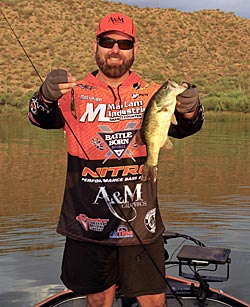
“Seems like everyone wants to be a guide,” says Matt, “but it isn’t easy.” First, in Arizona, at least, you need a guide license, which costs $300. Then you have to decide where you want to guide. Different lakes are managed by different entities, and they all charge guides. For instance – if you want to guide on lakes in the Tonto National Forest, it costs $100 per year for 4-5 trips, then a percentage of what you make on trips after that. Want to guide on Lake Pleasant? That’ll be $250 or so plus a percentage.
In addition to fees, you need a million-dollar liability policy naming the managing entity as a beneficiary. Your basic boat insurance does not cover you if you are guiding. If you want to guide on the Colorado River lakes, that’s another thing – you need a Captain’s License. It takes a couple of trips a year to break even.
You can always opt to work for a guide company and just cut the fee, which can save you a lot of headaches, but you don’t make as much money. And, of course, some guide illegally and call it “on-the-water seminars” or whatever, but that’s taking a lot of risks. If anything ever happens, you have a lot to lose.
Another thing you might not think of is the pressure. If you can’t get bit, your clients won’t be happy. How would you like to pay upwards of $500 (plus gas) for a day with no fish? As a fisherman, you know that cold fronts and other weather conditions can make a day on the water difficult. For instance, if there is a strong wind, your clients may not even be able to cast. Matt says some guys go out anyway and take the money, but he can’t do that. Since he’s independent, he’ll call and re-schedule the trip. If the client insists on going even after being told how difficult it will be, he’ll take them, but he is always willing to quit part way through and re-schedule.
Another thing you have to consider is equipment and baits. You provide all that for your clients, sandwiches, snacks, water, etc. Matt keeps eight-rod rigs up, so for two clients, that’s four rods each. You never know if they will break off, backlash, etc. Matt says that as a guide, you should ensure that all they need to have when they show up is a hat and sunblock. You watch them to see if they know how to cast, whether they can use a baitcaster, etc., and base what equipment you use on that.
Matt says that you are a great tournament fisherman doesn’t mean you’ll be a great guide. It’s an entirely different mindset. In a tournament, he wants five bites. Five BIG bites. But as a guide, he wants action. Clients don’t care if they catch small fish all day, as long as they catch fish. If you think you can do all that, maybe being a guide is something you would like. Matt mostly gets the word out through social media and clients recommending him to others. He says it’s fun and rewarding most of the time and he enjoys teaching people how to fish. He even makes trips where he teaches tournament fishermen how to use graphs. Matt’s website www.mattshurafishing.com is where he features photos of clients showing off their catches.
Those are just three ways that people I know have turned their love of fishing into a side hustle. I also know a young angler who plans to attend college to become a lure designer. Some people spend their evenings in the garage carving custom swimbaits, designing and sewing fishing clothes, starting custom embroidery businesses, and learning to do wraps – endless possibilities. If you want to do what you love, start – you can keep your day job until you don’t need to. The sky is the limit.



